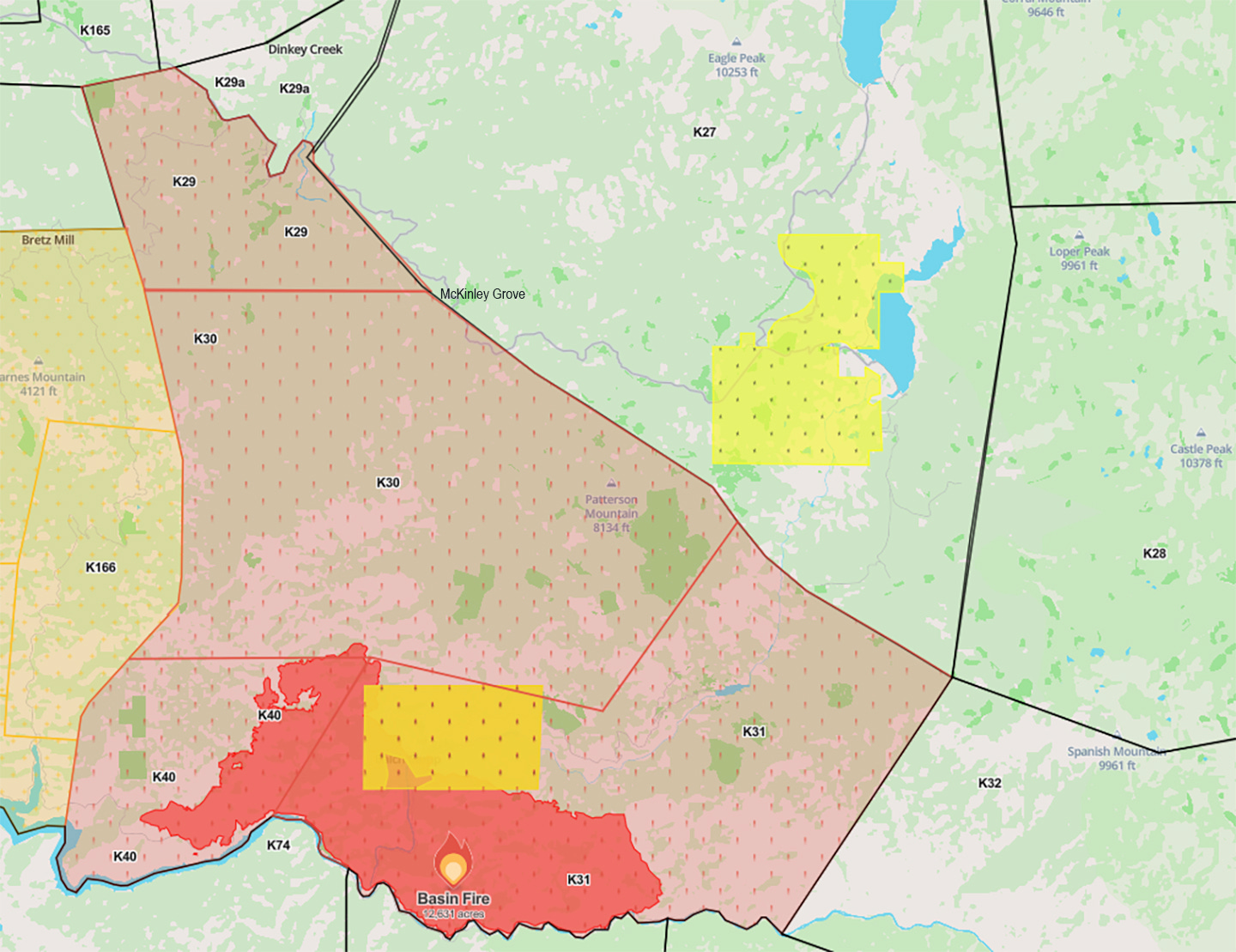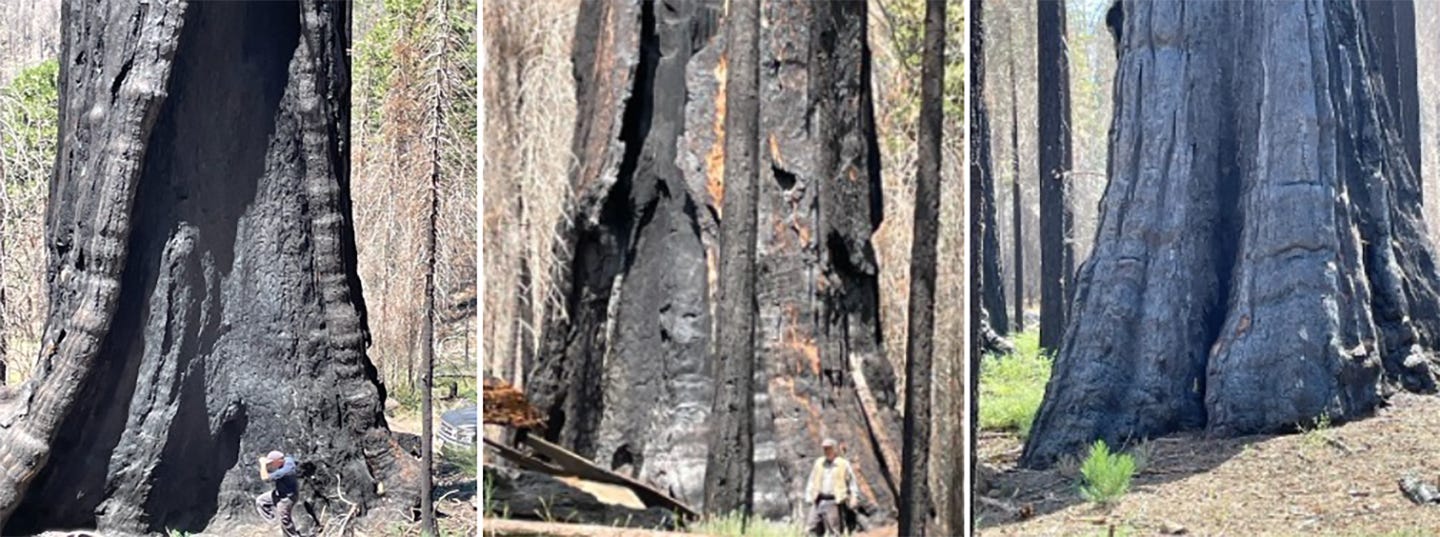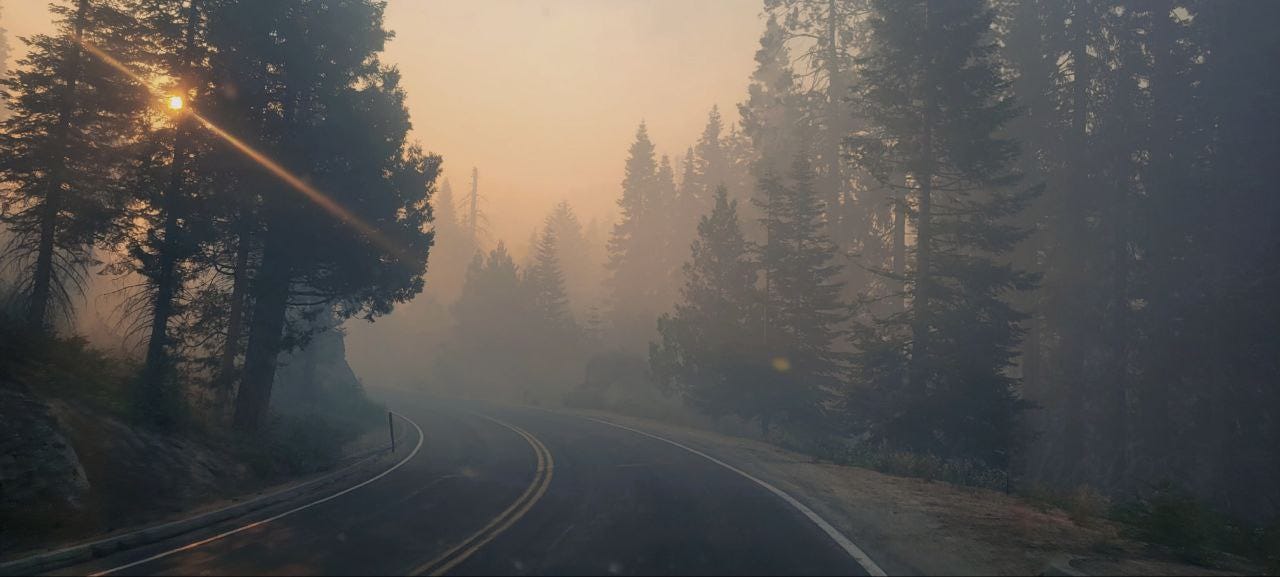Volume 2, Number 59 - Monday, July 1, 2024
Published every Monday and Thursday

Perspective
SIERRA NATIONAL FOREST continues its effort to knock down the Basin Fire with excessive heat warnings in the forecast, along with steep terrain and heavy smoke.
As of the latest report this morning, the fire was at 12,631 acres with no containment.
That’s not great news on many fronts, with the July 4 holiday just days away.
The Forest Service has been posting updates on SNF’s Facebook page HERE and Inciweb HERE. WatchDuty HERE shows areas with evacuations, and you’ll see a screenshot below. From what I can tell, the fire is still south of McKinley Grove of giant sequoias. I’ve reached out to SNF to see how close it might be and if they’re doing anything specific to protect the Big Trees there. I haven’t heard back, but I suspect they’re pretty busy.
The nearby Flash/Bolt Fire — which has also been referred to as the Fresno June Lightning Complex — is at 10,375 acres and 69% contained this morning, per Cal Fire Fresno.

YOU MAY RECALL my report on May 2 about a talk activist Chad Hanson made at the April 27 meeting of the Kern-Kaweah Chapter of the Sierra Club in Bakersfield. If you missed it, you can read it HERE. You might also recall a piece journalist Rick Elkins wrote for the Aug. 17, 2023, edition about a field trip members of Camp 70 Foresters made to Long Meadow Grove. You can read it HERE.
The Camp 70 Foresters are a group of former forestry classmates who attended the University of California Forestry summer camp near Quincy, California, in 1970 and graduated with B.S. degrees in Forestry.
Reader Ron Cerruti, who is a member of the group, submitted the piece below, which he said was written following the group’s recent bi-weekly discussions — and is intended as a rebuttal to Hanson’s Sierra Club talk which was entitled “The Most Misunderstood Tree on Earth: The Fire-Dependent Giant Sequoia and its Struggle to Survive Our Love.”
“It is direct in its content and tone,” Cerruti said of the submission, which you can read below. “The 2024 wildfire season is here, and more giant sequoia groves will be threatened. The current Basin Fire is a case in point,” he added.

Camp 70 Foresters respond to Chad Hanson’s views on giant sequoias
By Vladimir Steblina
Camp 70 Foresters*
SINCE 2020, about 20% of the world’s largest monarch giant, sequoia trees, have been killed by high-severity wildfires. Legal maneuvers by environmental groups, including the Sierra Club and Chad Hansen’s John Muir Project, have prevented agencies such as the U.S. Forest Service and the National Park Service from managing the giant sequoia groves and adjacent overly dense forests. Rather than protecting these unique trees as touted, the group’s actions led directly to the destruction of these ancient trees when inevitable wildfires swept unchecked across the landscape. Astonishingly, these groups and individuals still advocate a “no touch” approach rather than thoughtful forest management that has proven effective in minimizing the loss of these irreplaceable treasures.
This has led to over 90 million acres of wildfires that have destroyed entire communities, natural landscapes, and endangered species, and the carnage will continue every year until we finally reach a new, different ecological condition.
But the worst loss will be the giant sequoia forests, of which only 74 exist worldwide.
We have lost 20% of the monarch sequoias, and the threat of further loss looms large unless we take action. Several groves (forests) have been destroyed, including Homer’s Nose and Board Camp. High-intensity wildfires in other groves have killed many of the large trees. This is not just a significant loss; it is a tragedy. We must advocate for thoughtful forest management to prevent further loss of these irreplaceable treasures.
In his talk to the Sierra Club, Chad Hanson asks, “Does high-intensity fire actually threaten them? Or is it more complicated than that?”
Yes, and it is not complicated.
Chad Hanson needs to walk into what is left of the giant sequoia forest at Homer’s Grove and Board Camp. Better yet, he should have walked into those groves as I did a half-century ago and seen the growth in white fir and other mixed conifers that would destroy them.
Chad Hanson states that high-intensity fire is necessary for giant sequoia to regenerate.
That is NOT true.
Giant sequoias only need bare mineral soil, moderate sunlight, heat, or light to moderate fire to open the cones for natural regeneration.
The high-intensity fires that Chad Hanson champions create bare mineral soils, but they kill giant sequoia that are thousands of years old and will not exist again for thousands of years.
Chad Hanson does not understand how the forests in the Sierra Nevada have changed over the past 10,000 years since human manipulation began.
The Native Americans were outstanding foresters. They created the management practice of low-intensity fires to create a landscape that met their need for plant food crops and brush species for deer and other food animals. This continued until early in the 20th century when foresters trained in European forest techniques shifted the management from understory species to trees.
Europe faced timber famines, and its emphasis on producing wood fiber became ingrained in American forest management. Foresters shifted tree management in the American West to “full-stocking levels” to meet the needs for mining timbers, railroad ties, paper products, and building materials to meet the needs of a fast-growing population.
It was widely successful.
Timber growth in the U.S. increased every year in the 20th century. Even with the high harvest levels, more trees were growing in the U.S. than we were harvesting. The forests were changing due to fire exclusion, but more wood created a dense, urban society on the new continent.
Except for a few foresters early in the last century, the forestry profession embraced “full stocking” as desirable. Still, more importantly, the environmental community came to believe that dense forests were the natural condition.
They are NOT the natural condition.
The establishment of the Sequoia National Monument by President Clinton and the failure to follow the lessons of forest science published by the National Park Service and the University of California at Berkeley forest scientists resulted in little to no management of the giant sequoia groves and their surrounding lands.
This, along with the National Park Service's refusal to follow forest science and its inability to implement management to save the trees, sealed the fate of giant sequoia groves in the 2020 wildfires.
From 2011 to 2020, wildfires and insect and disease infestations led to the loss of one-third of the conifer forests in the giant sequoia area.
A team of forest ecologists ended their research paper with the following warning. “Remaining dry, mature forest habitat in California may be susceptible to complete loss in the coming decades without a rapid transition from a conservation paradigm that attempts to maintain static conditions to one that manages for sustainable disturbance dynamics.” **
John Muir wrote over a hundred years ago, “We therefore conclude that the area covered by Sequoia has not been diminished during the last eight or ten thousand years, and probably not at all in post-glacial times.”
That is until 2020, when we lost 20% of the monarchs and several sequoia forests.
We are on the verge of losing most of the enormous giant sequoia.
Once they are gone, they are gone.
Future generations will harshly judge Chad Hanson and today’s environmental movement for their important role in destroying our giant sequoia forests.
Notes:
* Vladimir Steblina is the principal author of this article. He is a member of the Camp 70 Foresters, who graduated from the University of California at Berkeley Forestry School in 1972. Their review comments have improved this article. In 1974 and 1975, Steblina worked for Hammon, Jenson, Wallen & Associates as the project manager for the Giant Sequoia Inventory and Mapping project in Sequoia National Park. As project manager, he hiked and explored every Giant Sequoia Grove south of the Mineral King Road in Sequoia National Park except Dennison Grove. He and the rest of the Camp70 Foresters are outraged at the destruction of the planet's most iconic tree species.
** Steel, Zachary L., Gavin M. Jones, Brandon M. Collins, Rebecca Green, Alexander Koltunov, Kathryn L. Purcell, Sarah C. Sawyer, et al. 2022. “Mega-Disturbances Cause Rapid Decline of Mature Conifer Forest Habitat in California.” Ecological Applications e2763. https:// doi.org/10.1002/eap.2763

Park Ridge prescribed burn update
I’ve reported on SEKI’s most recent prescribed burning in the last two newsletters. Here’s the latest NPS report, from Saturday morning:
Sequoia & Kings Canyon National Park is transitioning the Park Ridge Prescribed Burn to patrol status for ongoing monitoring. This proactive measure allows firefighters to swiftly address any potential hot spots or flare-ups, maintaining effective control over the fire.
Just a reminder to visitors and residents they may still see smoke in the internal footprint of a fire, it typically means that there are still burning or smoldering materials within the burned area. Even after the flames have been extinguished or controlled, certain fuels such as logs, roots, or thick vegetation may continue to smolder. This can produce smoke that rises from the ground or drifts up intermittently.
This transition signifies a significant milestone in the burn's management, showcasing the professionalism and expertise of the firefighting team. Continuous monitoring of the area not only ensures environmental safety but also reassures the local community that the situation remains under control.
Visibility in the area is low. Please drive carefully with your headlights on and be mindful of firefighters working nearby. There will be no more updates on this prescribed burn.
Wildfire, water & weather update
CalFire’s incident map is (HERE). Heat in the San Joaquin Valley and the upcoming July 4 holiday are likely to send more people to the mountains, making fire safety extremely important. The best Sierra Nevada weather forecasts are at NWS Hanford, HERE, and NWS Sacramento, HERE.

Did you know you can comment here?
It’s easy to comment on items in this newsletter. Just scroll down, and you’ll find a comment box. You’re invited to join the conversation!
Thanks for reading!




Though not an expert in any sense, I agree with the Camp70 statements that "Astonishingly, these groups and individuals still advocate a “no touch” approach rather than thoughtful forest management." I am reading Ethan Tapper's "How to Love a Forest" and heard him speak yesterday and he also would agree strongly with Camp 70.
- As an aside: "high-intensity fire is necessary for giant sequoia to regenerate." All of the sequoias on Palomar Mountain regenerate naturally without fire.
- Re: "the giant sequoia forests, of which only 74 exist worldwide." I sound like a broken record, but there are five regenerating groves in southern California, many larger than some northern California groves. And there are more than 500,000 sequoias in England alone. So there are many more than 74 sequoia groves in the world.
Re: Camp 70 Foresters photo caption, I don’t think Hanson and the Club considers that little seedling to be the equivalent to what is identified in the photo as the “dead" giant sequoia. While looking at the photos we can’t tell whether or not those trees are, in fact, dead. Loss of green needles in the fire doesn’t necessarily mean the tree is dead. Other than observing that “Oh, my God, they’re black and their needles are gone . . .” how was their demise determined?
Closer examination of the tree is needed to make that determination as a live tree can loose its leaf canopy and come back. The question can be answered by examining the cambium buried deep behind that thick layer of bark that appears to remain on the trees in the photos despite being blackened on the surface.
Referring to the content of the Camp 70 story, Hanson explained the impact of high intensity fires on the seed bearing sequoia cones. (Hotter fires, more seeds release) I didn’t see Hanson’s comments as meaning only high intensity fires can facilitate regeneration of sequoias but that hotter fires engender greater seed release from cones did he not?
Camp 70’s Vladimir Steblina rather glib and disingenuous statement that Hanson does not understand how the forests in the Sierra Nevada have changed and that he should “walk into what is left of the giant sequoia forest at Homer’s grove and Baird Camp" is a leap of logic. Admittedly he did not walk into these places 50 years ago as apparently Stabling did for a very obvious reason. However, he routinely leads walks into the groves at various places to observe, consider and discuss the natural processes he’s talking about as they are now occurring. So, despite Steblina's insinuation, Hanson’s conclusions are based on actual observations and study. They’re not some sort of ivery tower dreamscape as Steblina insinuates nor are the policies as advocated by the John Muir Project and environmental groups, specifically the Sierra Club, destroying anything.
While I think we agree that European forestry practices superseded the more beneficial to the long range forestry health by the First Americans, it appears to me that the desired practices now advocated by Camp 70 and the forest and park service still treat the forests as sort of an agricultural crop as insinuated by the backhand swipe at former President Clinton in having the audacity to declare a national monument.
And, here’s an interesting statement: "Timber growth in the U.S. increased every year in the 20th Century. Even with the high harvest levels, more trees were growing in the U.S. than we were harvesting. The forests were changing due to fire exclusion, but more wood created a dense, urban society on the new continent."
Admittedly I lack the background to challenge that statement but I do recall family owned and run Pacific Lumber of Scotia California harvested sustainably. That is, until in 1986, they were taken over by Maxxam Corporation of Texas in a leveraged buyout.
To pay down their debt Maxxam increased harvesting beyond sustainability. It took 20 years of ill considered business practices for Maxxam to bankrupt Pacific Lumber. The plant is now permanently closed.